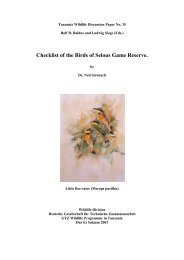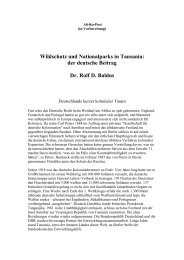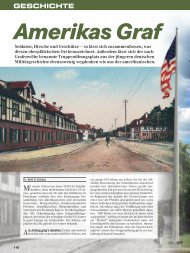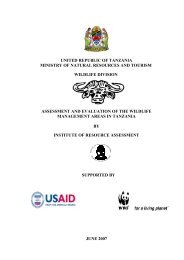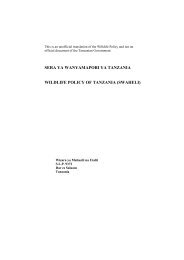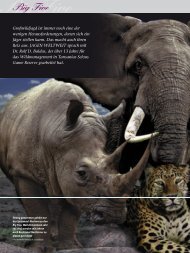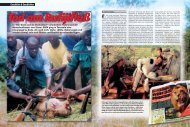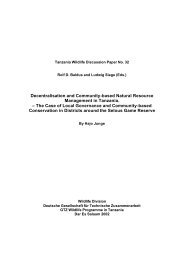African Indaba Articles - wildlife-baldus.com
African Indaba Articles - wildlife-baldus.com
African Indaba Articles - wildlife-baldus.com
You also want an ePaper? Increase the reach of your titles
YUMPU automatically turns print PDFs into web optimized ePapers that Google loves.
Until 1960 <strong>wildlife</strong> was in serious decline in Zimbabwe but the pattern was <strong>com</strong>mon in much of Africa.Colonial legislation focused responsibility for managing <strong>wildlife</strong> in top-down bureaucracies, denied itsinherent economic value and prevented people on the land from managing it in conjunction with the rest ofthe ecosystems of which it was a part. As a result, decision makers over looked its value, from politiciansand civil servants to landholders who decided its fate on the ground. Population numbers and <strong>wildlife</strong>habitats declined through overt action to eliminate a worthless <strong>com</strong>petitor for the benefit of agriculture orsimply from benign neglect.The decline in the <strong>wildlife</strong> resources of the country were halted and reversed with the introduction of theWildlife Conservation Act (1960). Inauguration of the Act heralded a period of 15 years of adaptiveinstitutional reform. Landholders were allowed greater discretion over the management of <strong>wildlife</strong> on theirland and could market its products with increasing freedom. Landholders were encouraged to maximise theirprofits from using <strong>wildlife</strong> sustainably. Benefits from the resource and accountability for conserving it werebrought close together where they could interact positively and serve as a positive incentive for landholdersin whom authority over the management of <strong>wildlife</strong> was now centred.Institutional frameworks immediately halted and reversed the downward trend in large wild mammalpopulations. Furthermore, with the institutional framework in place, <strong>wildlife</strong> was able to benefit from thedeclining terms of trade for ubiquitous agricultural <strong>com</strong>modities that <strong>com</strong>menced in the mid 1970s. Farmerswho had <strong>com</strong>plained that they could not “farm in a zoo” now accepted that they could not farm sustainablyand profitably “outside the zoo”. In switching to <strong>wildlife</strong> alone or in <strong>com</strong>bination with livestock theydemonstrated the economic importance of having conserved the biological diversity inherent in a spectrum oflarge indigenous mammals and their habitats.Confidence gained and lessons learned by the institutional reform process were consolidated andextended in the Parks and Wildlife Act, 1975 that replaced it. This Act recognised National Parks and fiveother classes of ecological reserve and provided for the better management of the reserves and <strong>wildlife</strong>,including fish, outside their borders. Landholders were allowed considerable freedom in the managementand marketing of the <strong>wildlife</strong> and its derivatives from their land, without Government abrogating itsresponsibility for ensuring the proper conservation and use of the resource. Discriminatory implicit taxation,such as through the imposition of government hunting licence fees, and high transaction costs through anunreasonable requirement for permits, were effectively abolished. Instead, landholders including the Stateon State Land were encouraged to maximise the benefits earned by the resource within the limits of the landuse policy for each property.Within a decade, land with significant <strong>wildlife</strong> exceeded 30% of the country, with that in the private and<strong>com</strong>munal agricultural sectors exceeding the area of the Parks and Wildlife Estate. A financially importantindustry dominated by recreational hunting and tourism and their ancillary services had grown up around thetwo, and the private sector was demonstrating improved environmentally friendly land use. Socioeconomicallysound institutional development had been integrated with ecologically sustainable resourcemanagement towards creating a self-supporting and holistic conservation programme.CAMPFIRE grew from the confidence in <strong>wildlife</strong>, as a productive, profitable and <strong>com</strong>petitive land use, thathad been tested on <strong>com</strong>mercial land. The two sectors remained mutually beneficial with <strong>com</strong>munal farmersbenefiting from the scales of operation, marketing strategies, examples, and standards provided by<strong>com</strong>mercial game producers. They in turn benefited from the <strong>com</strong>plementary range of trophy animalsavailable on Communal Land. Piggybacking <strong>wildlife</strong> use in Communal Areas on that in Commercial Areaswas largely responsible for making the former viable and able to help counter land degradation and mitigatethe resulting poverty vortex, even where the resource was limited. CAMPFIRE’s biggest short<strong>com</strong>ing wasthat benefits did not reach directly to the <strong>com</strong>munities, but were channelled through secondary bodies atDistrict level.3.2 Destruction of a Thriving Sector of the EconomyProfitable game ranching increased often to the exclusion of other forms of agriculture on <strong>com</strong>mercialfarms and ranches and the internationally renowned CAMPFIRE programme grew and flourished in the<strong>com</strong>munal areas, despite covert Government opposition. On <strong>com</strong>mercial land, <strong>wildlife</strong> was seen as a ruse toevade taxes, while on <strong>com</strong>munal land it was resented because it was a powerful democratising force eroding74



